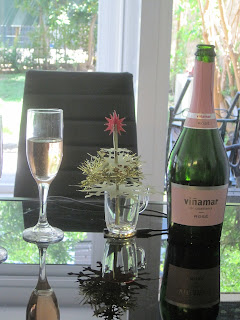I was a bit confused as to what to celebrate this year. As an evangelical atheist I'm not happy doing Christmas, but as most of the traditions we associate with it are generally derived from the older yuletide/solstice/Saturnalia festivals I can find enough of a technicality to still enjoy myself. The last time we were in the southern hemisphere in December in Oz there were no real local traditions to conflict with, so I stuck with the northern hemisphere schedule.
This year in South America however, there is a competing tradition for the shortest day, called Inti Raymi. Problem is, that was in June when we were still in the northern hemisphere, and just like the north there is no real festival for the longest day. So, we'll have to improvise.
Common to all solstice festivals seems to be eating and drinking too much, so that is always a good start. We usually try to do local food and drink and as Chile is primarily wine country we decided to let that set the agenda, so:
Brunch
Vina Mar sparkling rose from the Casablanca valley - we visited the winery a couple of weeks ago. Supported by hot smoked salmon from the Patagonian Fjordlands down south and scrambled eggs - Maria's favourite.
Lunch
Vina Cousino Macul rose - the winery is in south eastern Santiago and we visited yesterday so Kevin could do his first winery tour. Accompanied by fresh asparagus with hollandaise sauce, and Patagonian mussels mariniere.
Vina Cousina Macul 1989 Cabernet Sauvignon - Kevin's treat - with local pork pate stuffed mushrooms.
Vina Cousina Macul quirky Merlot - again, Kevin's choice from his tasting and very different to most Merlots in that it is very tannic with a strong wood influences, almost like a port. With slow cooked pork ribs as the closest we could get to belly pork in the local supermarket, and in a complete bizarre twist, a light marinade of barbecue sauce from Tiptree in Essex, all of 15 miles from where Kevin and I grew up. How this happens to be in a supermarket in deepest darkest Chile we have yet to work out.
Vina Cousina Macul Syrah - still my favourite grape. And something to go with the variety of local cheeses.
Unfortunately they don't have a big tradition of fortified or sweet dessert wines here, but I did knock up a seasonal summer pudding as there is a lot of soft fruit grown here, including the first redcurrants we have seen in years. Kevin created a mini tree, complete with flashing lights, which made it feel more festive.
We decided to forgo the pasta and broad beans as we have to get up early tomorrow for our flight to Rapa Nui.
This year in South America however, there is a competing tradition for the shortest day, called Inti Raymi. Problem is, that was in June when we were still in the northern hemisphere, and just like the north there is no real festival for the longest day. So, we'll have to improvise.
Common to all solstice festivals seems to be eating and drinking too much, so that is always a good start. We usually try to do local food and drink and as Chile is primarily wine country we decided to let that set the agenda, so:
Brunch
Vina Mar sparkling rose from the Casablanca valley - we visited the winery a couple of weeks ago. Supported by hot smoked salmon from the Patagonian Fjordlands down south and scrambled eggs - Maria's favourite.
Lunch
Vina Cousino Macul rose - the winery is in south eastern Santiago and we visited yesterday so Kevin could do his first winery tour. Accompanied by fresh asparagus with hollandaise sauce, and Patagonian mussels mariniere.
Vina Cousina Macul 1989 Cabernet Sauvignon - Kevin's treat - with local pork pate stuffed mushrooms.
Vina Cousina Macul quirky Merlot - again, Kevin's choice from his tasting and very different to most Merlots in that it is very tannic with a strong wood influences, almost like a port. With slow cooked pork ribs as the closest we could get to belly pork in the local supermarket, and in a complete bizarre twist, a light marinade of barbecue sauce from Tiptree in Essex, all of 15 miles from where Kevin and I grew up. How this happens to be in a supermarket in deepest darkest Chile we have yet to work out.
Vina Cousina Macul Syrah - still my favourite grape. And something to go with the variety of local cheeses.
Unfortunately they don't have a big tradition of fortified or sweet dessert wines here, but I did knock up a seasonal summer pudding as there is a lot of soft fruit grown here, including the first redcurrants we have seen in years. Kevin created a mini tree, complete with flashing lights, which made it feel more festive.
We decided to forgo the pasta and broad beans as we have to get up early tomorrow for our flight to Rapa Nui.


































